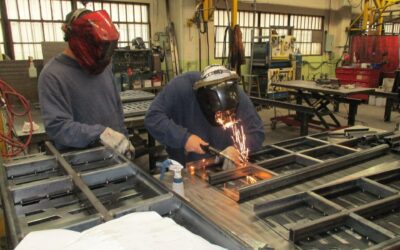Originally published in THE FABRICATOR® MAY 2015
By: Charlie Hopewell, Dave Davidson, Gary Conner
Employees and managers experience a lean transformation in vastly different ways. Understanding these viewpoints can help change a company culture to one that embraces continuous improvement.
When managers, supervisors, or front-line workers have no interest in change, even though they aren’t meeting customer expectations or achieving their own goals, is it because they don’t understand how dynamic a lean transformation really is? Perhaps, but it may also be because their perspectives are shaped by their day-to-day experiences, such as that welcome cup of coffee during a lengthy changeover.
The following case study describes perspectives from employees—a machine operator, a front-line supervisor, a plant manager, and a CEO of a typical fabricator—before and after the implementation of lean thinking.
The Machine Operator
Before Lean Manufacturing
I began my career as a press brake operator at a precision sheet metal company. The supervisor who hired me told me that my job was to “step on the pedal of this press brake 2,000 times a day.” I desperately needed the job, so I made sure that I stepped on the pedal 3,000 times every day. Because our company was broken into functional departments, the press brake department produced piles and piles of products that were sent on pallets to the next operation, generally hardware insertion or plating.
From my perspective, it was wonderful to see forklifts moving 6-ft.-tall stretch-wrapped pallets of product from my machine to the next department. I was getting measured on how much product I could push through my department, regardless of whether the next department was ready for it. The bigger the lot size, the better I liked it.
Setups on our press brakes averaged 36 minutes. This included time spent gathering materials, paperwork, logging off and onto jobs, retrieving tools, programming multiaxis press brakes, and, of course, getting a cup of coffee.
While I always tried to focus on productivity, I viewed machine setup as the most enjoyable part of my day. It was a chance to get creative, a chance to get away from the machine for a while. I averaged three setups per day. This translated to about 108 minutes of setup time per day (18 percent of a 10-hour day). We had five press brakes, so our department did about 600 setups per month across both shifts.
All that changed when our customers began ordering weekly instead of monthly batches. Our 600 setups per month became 2,400. At 12 setups per day, each operator was now having 432 minutes of machine downtime (36-minute setup × 12) every shift. This meant we were now spending up to 72 percent of our time setting up equipment. Our company began hemorrhaging money, and we quickly realized we needed to focus on a few fundamental lean tools: setup reduction, 5S (workplace organization), standardization and best practices, and small lot sizes.
It took months to fully transform our press brake team. At that point our plant was still arranged in functional departments. We had to address the fact that smaller lot sizes meant the number of material movements between departments grew exponentially. The logical next step was to break functional departments into cellular teams, where each team had a punch press, press brake, hardware, and other necessary supporting equipment, all running at a predetermined rate and balanced to true customer demand.
After Lean Manufacturing
Instead of stepping on a press brake pedal 2,000 times per day, my new goal is to perform whatever activity helps my team move material through our manufacturing cell with the least amount of delays. Our traditional 36-minute setups now are 6 minutes or less. Even though we have quadrupled the number of setups per day, machines spend less than 12 percent of the day in a downtime state for changeovers.
Our cellular teams are assigned specific types of products to work on, depending on the material type, process requirements, or customer. Each team has become experienced working with a narrower range of products and therefore become better at sequencing and producing that type of part. Productivity has more than doubled from $120,000 per person (sales dollars divided by number of employees) to nearly $240,000 per person. Because our company now has a gainsharing program, each team member is able to “feel” the improvement in a financially tangible way.
Maybe the greatest change of all is that each team member feels a closer bond with his or her group. Everyone feels like we are a “business within the business,” fully enfranchised and proud owners of our process.
The Front-line Supervisor
Before Lean Manufacturing
Most companies grow in fits and starts, and our company was no different. Like most sheet metal companies, ours started with one shear, one punch, a couple of press brakes, and one hardware insertion machine. We processed around 100 work orders per month. The material management system was a Lotus 123 (precursor to Microsoft Excel) spreadsheet.
When it came time to add a shear, punch press, or press brake, we placed them next to older machines. While this helped operators share knowledge, it required unnecessary transportation, and it may have resulted in the sharing of rack space and tooling. We also didn’t talk much with people in other departments.
This pattern continued until we had five punches, 10 press brakes, and all the supporting equipment—the classic “process village” arrangement. We didn’t really think about how the material moved in large batches between functional departments. Each department was assigned a supervisor, and each supervisor was responsible for maximizing the resources in that department, “pushing” up to 500 work orders through the pipeline each month.
We couldn’t manage this in our head (or in a spreadsheet) anymore, and we realized that we needed a $250,000 enterprise resource planning (ERP) package to manage all of the work orders. We spent much of the day expediting items or sitting through meetings to verify whether the data in the ERP system was correct.
After Lean Manufacturing
With departments changed into cellular teams and operations aligned into five smaller value streams, the departmental supervisors are now value stream leaders. Each is effectively a “production manager” of a small company. By dividing the operation into value streams, each value stream leader is now responsible for only 100 work orders instead of 500.
While this means I have full accountability for the work order from start to finish, I’m less stressed and more satisfied about my job. I have a more meaningful and richer work experience. Instead of being at the mercy of another department supervisor, I’m in greater control of my destiny. An added bonus: We have less expediting and less interdepartmental chaos.
The Plant Manager
Before Lean Manufacturing
The words I used to describe the day-to-day operations at our company were chaotic, random, and firefight. We spent each day catching up, looking for something, or getting caught off-guard.
We based the compensation system on a piece-work rate of pay. To achieve these financial objectives, operators churned out as many parts in as little time as they could. No one gave a second thought to the problems that overproduction created. Departmental supervisors managed the shop floor, and they divided the backlog into buckets of work designed to maximize efficiency for each resource rather than enhance material flow.
After Lean Manufacturing
New words come to mind: planned, disciplined, and executed. I don’t mean disciplined in a negative way. We’re like a well-disciplined sports team: Everyone knows his or her role and carries it out.
Besides physical changes such as specialized delivery carts that hold a predetermined number of products that are delivered to the customer in four-hour cycles, other changes help ensure sustainability. While we still have piece-work compensation in place, we don’t reward anyone individually. Instead, we issue a financial reward only if the entire team can move a quality product out the door on time.
This has driven a change in behavior that has everyone in tune with what’s going on up and down the value stream. We no longer drive local efficiency at the expense of global efficiency. In other words, we don’t increase efficiency in one area only to overwhelm another department with parts it doesn’t need or can’t handle.
Individuals manage themselves. While we still have a management structure, the titles are different. “Supervisors” are now “facilitators.” Instead of being directive, facilitators provide teams with clear production objectives for the day, and the individual teams develop a daily strategy for hitting those targets.
Facilitators are free to spend time on higher-order issues like identifying constraints, making sure that teams have clear objectives and the resources to achieve them, and ensuring that fluctuations in work flow are being smoothed out where possible. We have fewer meetings, less work-in-process, fewer inventory hiding problems, and therefore better cash flow.
World-class manufacturing principles are counterintuitive, which makes sustainability the toughest nut to crack. Those who joined the company long after the transition didn’t live through the transformation, so they often don’t understand or buy in to the culture of using takt time, flow, and pull systems. We realize that we can’t assume people will just “get it.” That’s why we offer comprehensive lean education for everyone, both new and longtime employees.
Business cycles and changing economic conditions—both rapid growth and unexpected declines—also put the pressure on us. They test our resolve to stay the course rather than abandon it and go back to old behaviors.
Regardless, having lived through a number of lean transformations at other companies, I know that the “after” condition is much less stressful and much more financially rewarding than the “before” condition. The evolution (or revolution) is neither quick nor easy, but the rewards and the results are undeniable.
The CEO
Before Lean Manufacturing
Having managed three major turnarounds, I can now look back and see certain patterns. In each case, the catalyst that drove these companies to the financial precipice was actually what should have been viewed as a positive condition of rapid growth. Just at the moment of uptick, these organizations were not prepared or positioned with the assets (machines, suppliers, staff, and standard processes) to absorb growth. Chaos ensued.
The shop that started out as a mom-and-pop culture, where a few experts were responsible for meeting a few customer demands, was being forced into a head-spinning transformation in which an entirely new generation of people were being trained in processes that were locked deep in the minds of a handful of first-generation employees. Best practices and standardization weren’t on the radar. Who had time to develop process documentation when we were already behind on deliveries?
So the whirlpool of poor quality, missed deliveries, and increased costs exacerbated the problem. Customers put up with this bad behavior only in the short term. Soon, rapid growth was replaced by evaporating revenues and abandonment by unhappy customers.
I began by taking off my tie and collared shirt and heading to the production floor in my T-shirt. Observing front-line workers, I discovered what was keeping them from being successful: part shortages, poor equipment maintenance, and erratic scheduling systems driving unnecessary machine changeovers, some of which were seven hours long. Only one machine out of four operated at any time. Because of nepotism and the good-ol’-boys club, no one was willing to challenge the current state. The culture encouraged a don’t-ask-don’t-tell mentality. No one was asking questions, and no one was offering feedback.
I found out that our manufacturing engineer, who has been with us for 18 years, had never visited our key suppliers face-to-face. We were asking for specifications that were not just unreasonable, but unnecessary. This meant our vendors often were sorting and scrapping a lot of our products, further affecting our already long lead times and high costs.
We were doing the same thing in-house. For one job we hand-reamed a case that we learned was being press-fit anyway during assembly. Hand reaming made no difference to the fit and function of the part—a glaring example of overprocessing.
As with most turnarounds, a few people (generally middle and upper management) simply needed to go. We had five layers of management between me and the shop floor. I needed to change the DNA of the organization, and the only way to do that was to eliminate layers and get rid of those managers whose attitudes were “It’s my way or the highway.” We needed a new highway, and we needed new people driving the bus, people who believed that serving the front-line workers was the same as serving the customer.
We also needed to recognize that not everyone wants to be a manager. In the U.S. Air Force, not every pilot wants to be assigned a desk job; some just want to fly a plane. We don’t want to turn a perfectly happy pilot into a very unhappy desk jockey. We need good pilots (machine operators), and sometimes we think they must want to find their way into the office as a programmer, engineer, or manager, but that’s not always the case.
After Lean Manufacturing
We now have a positive reinforcement and a recognition system that rewards employees for their experience, loyalty, and tenure. We have a compensation package that financially rewards long-term machine operators (those happy in that role) for their years of service. As a result, we have lowered our turnover as well as those hidden costs associated with losing those who felt unappreciated or in jobs they didn’t like.
For the want of a nail the horse was lost; for the want of a horse the rider was lost; for the want of a rider the battle was lost; for the want of the battle the war was lost. This adage comes to mind when I think about how we scrutinized high-dollar components. We now realize that it’s the 5-cent washer that can hold up a $250,000 shipment, so we have point-of-use storage and vendor-managed inventory. No longer are on-time deliveries at the mercy of a commodity item.
We work with an off-site vendor to manage our high-volume components so that we can focus on building airtight processes for our high-mix, low-volume products. We regularly meet with each of our vendors, reinforce our goals, and make sure we get their commitment to help us achieve our objectives. By managing such details we eliminate the firefighting. No longer are we spending all of our time trying to placate irate customers. We now focus on order improvement opportunities like better quoting, improved supplier relationships, and positive and proactive customer interactions.
Our on-time delivery performance, quality, and profitability all approach world-class standards, and the cultural changes are now woven into the fabric of our organization. This obviously didn’t happen overnight. It took time. But the alternative was to see another American company fail, leaving the door open for even more jobs to move offshore.
Appreciating Different Perspectives
Note some trends in this story. Before lean practices were implemented, no one particularly enjoyed his or her workday. The machine operator rushed around trying to find tools and materials so he could change over machines again and again. From his perspective, small batches just threw a wrench into everything. He enjoyed the cadence of the day, producing parts, seeing a large batch leave, then changing over the machine for the next large batch.
The supervisor knew his job was to make sure his department pushed as many parts as possible to the next area—but he also knew his department was operating blind. Rarely did he communicate with other departments. Meanwhile, managers were in the thick of the chaos. Customers complained and threatened to pull their business. It got so severe that the chaos turned to noise, and perhaps became the new normal.
Plenty of factors affect how people perceive and welcome lean manufacturing, but appreciating other viewpoints can at least help you empathize and communicate, which in turn can lead to real change.
Stock photography is from Getty Images. This article appeared in Fabricator Magazine May 2015



